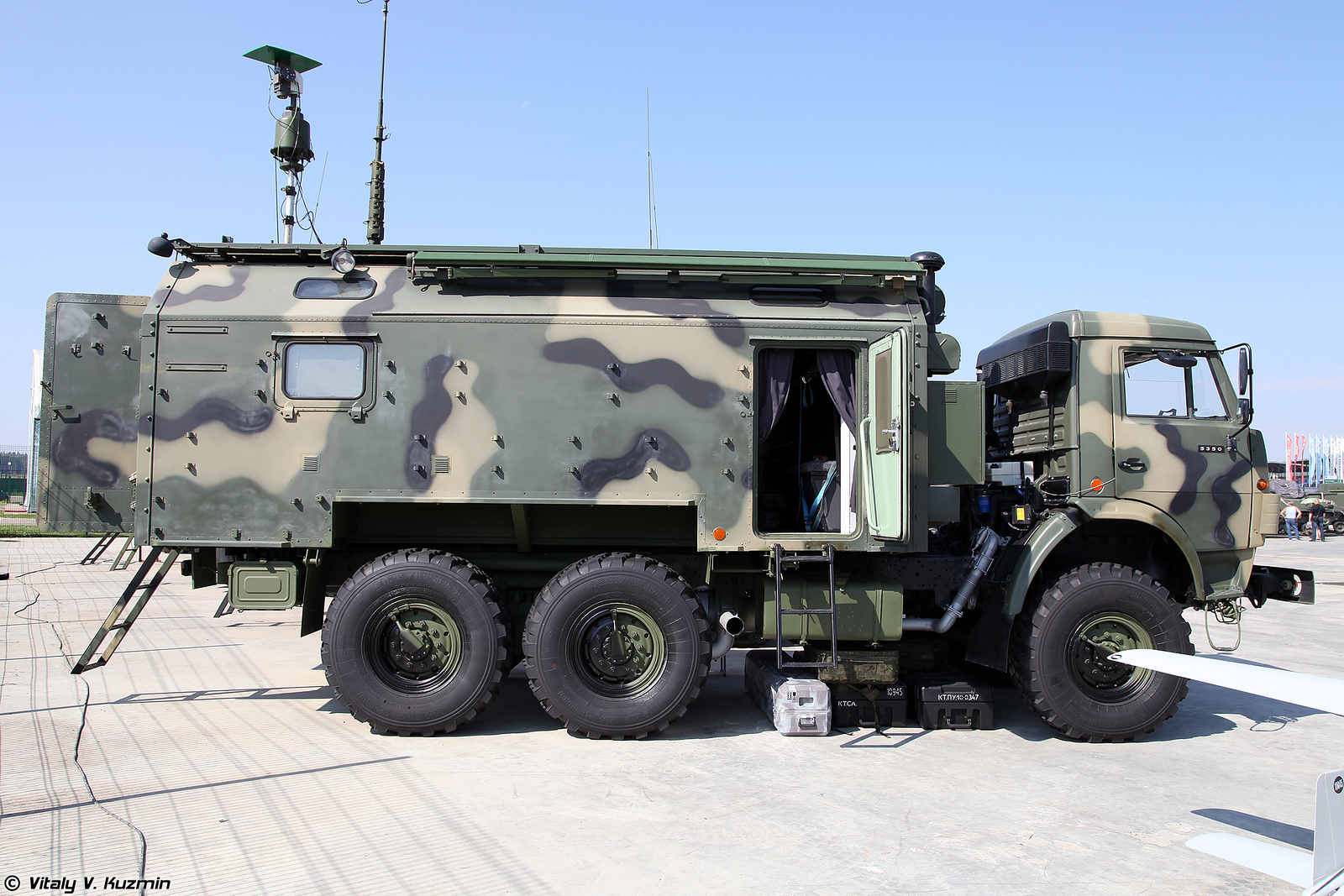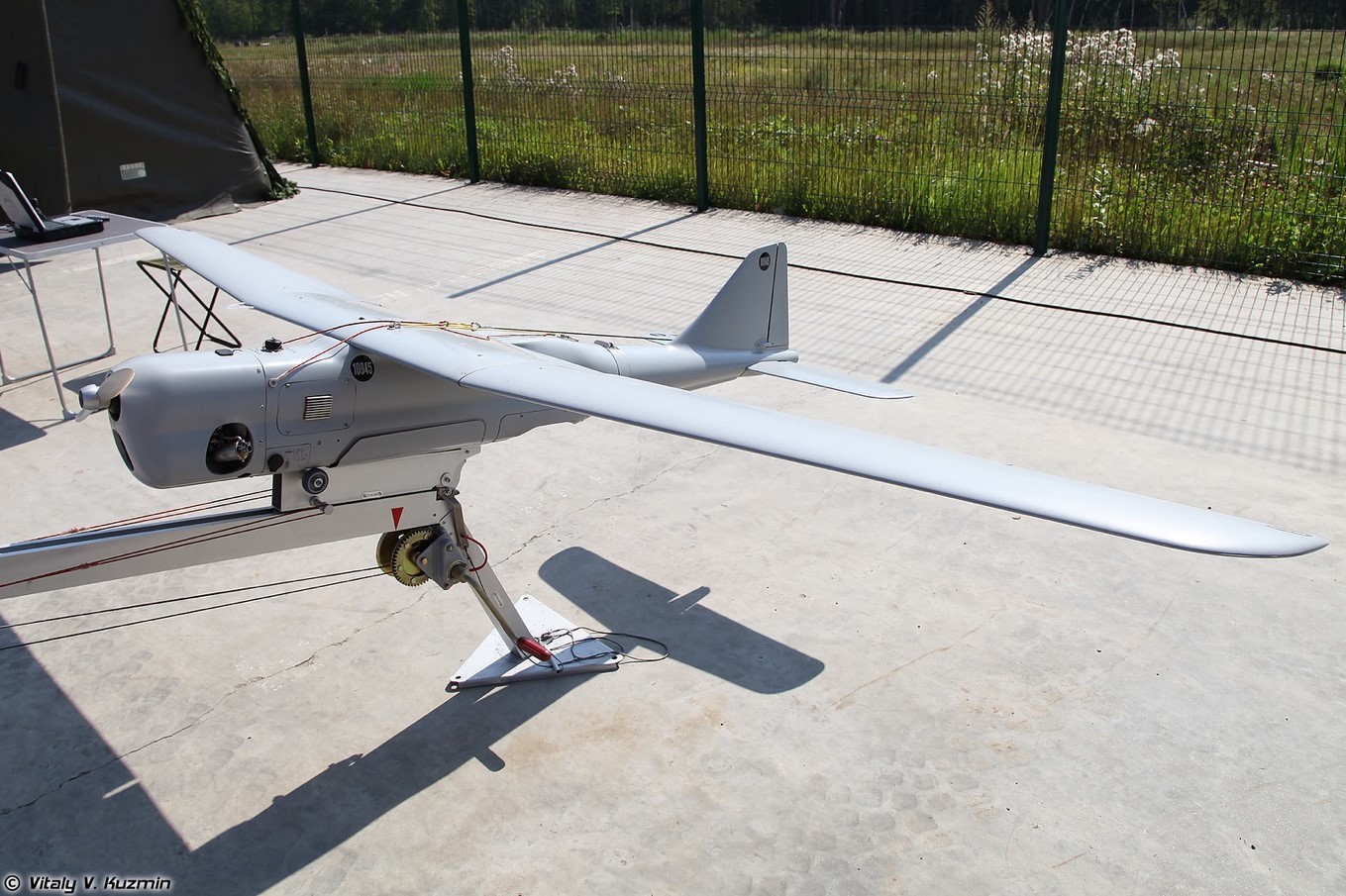
RB-341V Leer-3 with Orlan-10 UAV.

Orlan-10 UAV of the RB-341V Leer-3.
“According to Colonel General Alexander Zhuravlyov, the battalion’s addition to the division ‘will protect significant sites, increase the reconnaissance capabilities of the formation, and reduce the time it takes to obtain necessary information.’”
“The [electronic warfare] battalions will be equipped with Zhitel, Leyer-3 and Borisoglebsk-2 electronic warfare systems can conduct electronic intelligence and suppress the operation of communication and navigation systems…”
“There is no doubt that the use of the Leer-3 system not only severed communications between the combat groups and their foreign controllers, but also provided Kazakh security forces their geolocation data… The loss of a unified command and control by the terrorists and their inability to coordinate actions led to a completely natural result – the elimination of combat groups…”
Traditionally, Russian motorized rifle divisions and brigades each have an organic electronic warfare (EW) company. However, according to the excerpted articles from Russian newspaper Izvestiya and state-owned news agency Radio Sputnik, future motorized rifle divisions will have their EW company upsized to an EW battalion. According to Radio Sputnik, Colonel General Alexander Zhuravlyov, the commander of the Western Military District, stated that this change “will significantly increase the reconnaissance capabilities of the formation and reduce the time it takes to obtain necessary information.” Izvestiya notes that these new battalions will be equipped with the R-330Zh Zhitel jammer, the Borisoglebsk-2 EW suite, and the RB-341V Leer-3 EW/unmanned aerial system (UAS). Although EW companies already have the Zhitel and Borisoglebsk-2, the RB-341V Leer-3 will be a new capability at the brigade/division echelon. Previously, only the echelons above the maneuver brigade/division had this system. It is important to note that, aside from the RB-341V Leer-3 and more kit, these EW battalions will most likely closely resemble the EW companies from which they are derived, maintaining their tactical focus. This means that the EW battalions found in the motorized rifle divisions are far different from the EW battalions found at the Combined Arms Army level in terms of purpose, structure, and equipment, which includes the Palantin, Krasukha-S4, etc., as this type of an EW battalion has more of an operational focus.
The accompanying excerpted article from the weekly military and defense-focused newspaper Voyenno-Promyshlennyy Kuryer discusses the value of the RB-341V Leer-3 to security forces during the recent unrest in Kazakhstan. According to the article, “There is no doubt that the use of the Leer-3 system not only severed communications between the combat groups and their foreign controllers, but also provided Kazakh security forces their geolocation data.” The inclusion of the RB-341V Leer-3 in more numerous, lower-level, tactical units show the importance Russia places on cell phones in modern warfare. The RB-341V Leer-3 is not just envisaged to do cell phone jamming and geolocation, but also to influence the population by way of sending short message service (SMS) and audio messages, and eventually, even digital files.
Source:
“Россия усилила радиоэлектронную борьбу на границе с Украиной (Russia has stepped up electronic warfare on the border with Ukraine),” Radio Sputnik (state-owned news agency, news website platform and radio broadcast service), 25 January 2022.
https://radiosputnik.ria.ru/20220125/razvedka-1769436630.html
Russia’s Western Military District (WMD) has deployed a new battalion of electronic warfare systems in Belgorod Region, which borders on Ukraine, Russian news agency RIA Novosti reported on 25 January.
“A separate electronic warfare battalion became part of the Vislenskaya [3rd] Motorized Rifle Division of the Western Military District. Subdivisions of the new military unit are deployed in Belgorod Region,” the Western Military District said…According to Colonel General Alexander Zhuravlyov, the battalion’s addition to the division “will protect significant sites, increase the reconnaissance capabilities of the formation, and reduce the time it takes to obtain necessary information”…
Source: Bogdan Stepovoy, Roman Kretsul, Andrey Fedorov, “Ценность помех: в Западном округе создают батальоны радиоэлектронной борьбы (The Value of Jamming: Electronic Warfare Battalions Are Being Created in The Western Military District),” Izvestiya (large circulation Russian newspaper), 2 February 2022. https://iz.ru/1285283/bogdan-stepovoi-roman-kretcul-andrei-fedorov/tcennost-pomekh-v-zapadnom-okruge-sozdaiut-batalony-radioelektronnoi-borby
Electronic warfare battalions will be formed as part of several divisions of the Western Military District. The new units will protect troops, socially significant sites, and industrial facilities from strikes by precision-guided munitions. The battalions are equipped with complexes capable of suppressing enemy GPS systems, communications and navigation. The first such military unit was formed in Belgorodskaya Province and became part of the 3rd Guards Motorized Rifle Division. Experts note that this is an effective defense along the Russian border…
The battalions will be equipped with Zhitel, Leyer-3 and Borisoglebsk-2 electronic warfare systems can conduct electronic intelligence and suppress the operation of communication and navigation systems, military expert Aleksey Leonkov told Izvestiya…
“Operating as part of a division, the systems can carry out reconnaissance and jam sources of communication and control, as well as transmit the coordinates of aviation and artillery targets for strikes,” said Leonkov. “Each of them has its own specialization. The R-330Zh Zhitel jammer is designed to detect, find and jam signals and satellite communication stations, as well as navigation systems, including GPS. Such actions prevent UAVs, cruise missiles and other PGM from orienting themselves on the ground when striking… The Leyer-3 complex includes three Orlan-10 drones, which are used to jam cellular GSM communications… The main task of “Borisoglebsk-2” is the detection and suppression of various communication channels, including radio navigation systems.
Source: Vitaly Orlov, “«Леер» спас казахстан от сползания в пропасть (‘Leer’ Saved Kazakhstan from Sliding into the Abyss),” Voyenno-Promyshlennyy Kuryer (weekly newspaper focusing on military and defense industry complex issues), 25 January 2022. https://vpk-news.ru/articles/65512
On January 12, the Vietnamese edition of Soha published information about the use of Leer-3 electronic warfare systems by the CSTO peacekeeping contingent in Kazakhstan. According to the authors, this capability was one of the decisive factors in ensuring the successful outcome of the counter-terrorist operation of the Kazakh security forces. “There is no doubt that the use of the Leer-3 system not only severed communications between the combat groups and their foreign controllers, but also provided Kazakh security forces their geolocation data” the report says. The loss of a unified command and control by the terrorists and their inability to coordinate actions led to a completely natural result – the elimination of combat groups…
New drones capable of replacing cell towers have successfully passed the combat test program on the territory of the Syrian Arab Republic and have been officially adopted by the Russian Armed Forces. They have the ability to send audio and SMS messages to subscribers, and in the near future it is planned to add the ability to transfer video files. Since 2015, the drones that were part of the Leer complex have successfully suppressed base stations, but could not effectively resist 3G and 4G networks, which in turn created certain difficulties when interacting with smartphones. In modernized drones, these problems are solved. They “jam” the base stations, taking their place and becoming their virtual twins.
According to Denis Kuskov, CEO of the analytics company Telecom Daily, the “fake base station” created by the drone, unnoticed by the user, intercepts traffic and connection control, depriving him of the ability to connect to another base station. An operator controlling an unmanned aerial vehicle as part of the RB-341V Leer-3 gets the opportunity to generate calls and SMS messages to all subscribers within its coverage area…
Image Information:
Image: RB-341V Leer-3 with Orlan-10 UAV.
Source: Vitaly Kuzmin, https://photos.smugmug.com/photos/i-QX8bGpH/0/X3/i-QX8bGpH-X3.jpg
Attribution: CC BY-NC-ND 4.0
Image: Orlan-10 UAV of the RB-341V Leer-3.
Source: Vitaly Kuzmin, https://photos.smugmug.com/photos/i-JRLBkqD/0/X3/i-JRLBkqD-X3.jpg
Attribution: CC BY-NC-ND 4.0
